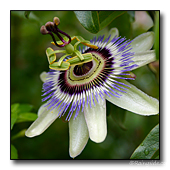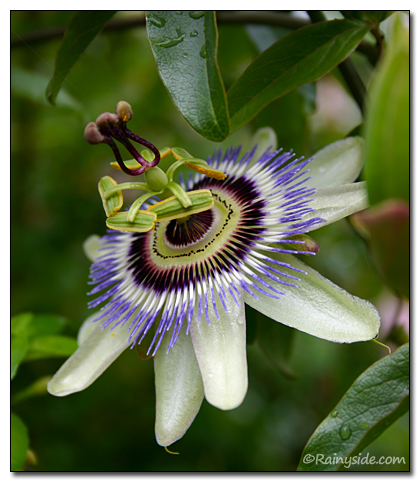Passiflora caerulea
BLUE PASSION FLOWER, PASSION VINE
Family: Passifloraceae
Pronounced: pass-iff-FLOR-uh see-ROO-lee-uh

Quick Jumps
Growing Guide
Rainy Side Notes
GROWING GUIDE

Origin:
Brazil and Argentina.
Plant Group:
Vines.
Hardiness:
Sunset zones: H1, H2, 5-9, 12-24.
USDA zones: 7-9.
Mature size:
Height: 30 feet (9 m).
Width: 6-15 feet (1.8-4.5 m).
Flowering period:
Summer to autumn.
Flowering attributes:
White, bowl-shaped, fragrant, flowers with blue, purple and white coronas.
Leaf attributes:
Deep green, glossy leaves divided almost to the base with usually 5 lobes.
Light:
Full sun.
Soil:
Fertile, humus rich, well-drained soil.
Feeding:
In spring, top dress with a complete organic fertilizer, and composted manure or compost.
Propagation Methods:
Sow seed and keep at 55-75°F (18-23°C), germination should occur rapidly. If germination has not occurred within 4 weeks, place seed trays where temperatures are 25-40°F (-3 to 4°C) for up to 4 weeks.
Layer branches in late winter.
Basal and softwood cuttings in spring.
Division in spring.
Semi-ripe cuttings in early summer.
Pruning Methods:
Lightly prune in spring taking a few stems down to the base.
Rainy Side Notes
It was an object of great awe amongst the children because of the dramatically revealed significance of the arrangement and shape of its parts...
~Louise Beebe Wilder
When I lived in Hawaii I used to go hiking on trails where the passion flowers grew. Many species are naturalized in Hawaii, and I can remember picking the fruits for pie, although not the same species as P. caerulea. Now that I grow it in the Pacific Northwest, for me the flowers evoke the feeling of being in a tropical rain forest. Unfortunately, in our climate we don't get any fruit. On the plus side, the plant does not pose any danger of naturalizing and taking over our temperate rain forests.
In my garden the vine is evergreen most winters. The winter of 2003-04 was cold enough to kill it back to the ground. However, because it is a fast growing vine, it quickly recovered. Passionflower is best grown against a south-facing wall in the colder parts of our region. The fragrant flowers are welcome in the garden during fall when other flowers are fading away. This vine is growing on a large fuchsia bush even though the vine is supposed to be growing up an arbor. It definitely has a mind of its own and doesn't appear to be satisfied with swamping the poor fuchsia. The vine is now reaching for a Cornus capitata tree growing nearby.
Photographed in author's garden.
A Pacific Northwest Plant of the Week (2013)

Gardening for the Homebrewer: Grow and Process Plants for Making Beer, Wine, Gruit, Cider, Perry, and More
By co-authors Debbie Teashon (Rainy Side Gardeners) and Wendy Tweton
Copyright Notice | Home | Search | Vines

